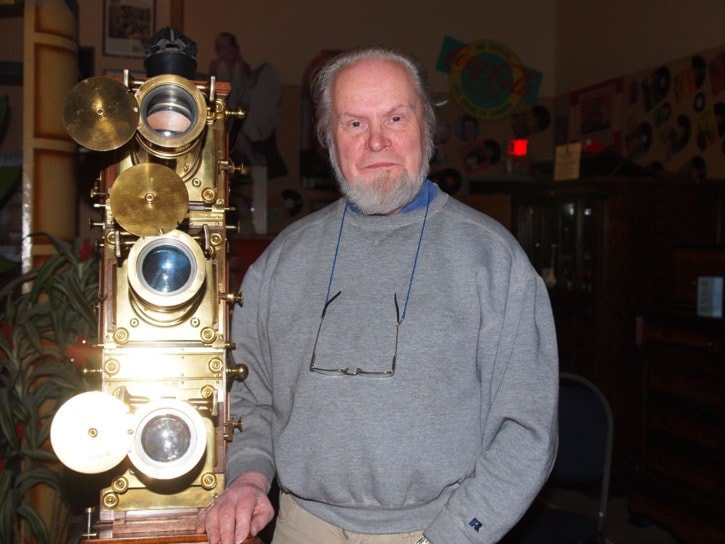As David Evans puts it, a magic lantern is basically a slide projector. “But if you call it a slide projector, it sounds rather boring.”
I was at the Nickelodeon Museum and Evans was showing me his tri-unial lantern – essentially three magic lanterns, one on top of the other. It’s the lantern he will be using to tell the story of Jean Noel at the museum this Thursday and Friday during the Grand Christmas Lantern Show.
“It means you have control over three different projectors so that you can project multiple images, you can dissolve from one lantern to another producing the effect, perhaps, of summer changing into autumn, changing into winter, changing into spring.”
According to the British Magic Lantern Society (of which Evans and his wife Lesley are members), the earliest record of a device similar to a magic lantern dates to 15th century Italy but it was not until the 1650s when Dutch scientist Christiaan Huygens developed the proper lantern. By the 18th century, there were hundreds of people developing lanterns and accessories.
The tri-unial lantern David showed me was made in London in the 1880s by a man name Chatham Pexton. The Evans acquired it at a Christie’s auction in the 1980s and they spent a year or so fixing it up before using it.
Their interest in magic lanterns started well before that, in the 1960s, when David was going to buy some antique clocks. While at the sale, he saw some wooden lanterns and, after doing some research, he bought a lot of them. They all came from the collection of a doctor, who they befriended and who gave them a book about operating lanterns.
With a lantern in their possession, the Evans put on shows for local photographic societies, church groups and others.
“Having got bit by the bug we had to get a triple lantern – the best one,” said David.
Lanterns are essentially early slide projectors – a light is cast through an image and a lens and projected on a white screen.
However, as the technology developed, people began to do more and more with them. Double, triple and even quadruple lanterns were made, giving projectionists the ability to dissolve images into each other or project more than one image at a time.
Artists also created moving slides, which could be used to simulate movement. One slide David showed me of a girl skipping rope had the rope painted on in two positions. A mask was moved back and forth so only one image of the rope was shown at a time. Then, he pulled back another part of the slide, which showed a policeman getting his helmet knocked off by the rope.
Another slide David showed me had two plates to it. One was an image of the queen’s fishing temple in Virginia Water, U.K. The second slide could be moved across the first, making it look like a procession of boats passing by.
He also showed me a rotating slide, where two identical images rotated in opposite directions. It’s nicknamed a disco slide and the Evans have about 40-50 of them.
“We dissolve one into another about every 10 seconds or so while the music is playing so that does produce quite a disco light show,” David said. “But it’s pretty unlikely they would have done that in the Victorian times.”
On Dec. 22 and 23, the Evans will be putting on a special Christmas lantern show. They will be showing the story of Jean Noel, with Reverend Ken Jones and the Harper family telling the story – like an old radio play.
Jean Noel is a French version of the story of King Wenceslas, Lesley said. The slides used for the show feature photographs of real people against painted backgrounds, Lesley said. They were made in England but the story is based in France.
The Grand Christmas Lantern Show takes place at the Nickelodeon Museum on Dec. 22 and Dec. 23 at 7 p.m. each night. A suggested donation of $12 is asked for entry. All proceeds will go to the food bank.
